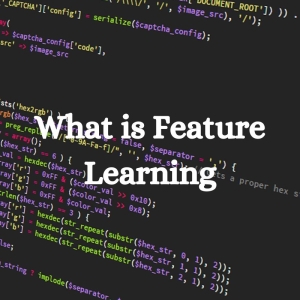What is Feature LearningPosted by Archi Jain on August 22nd, 2023  What Is Feature Learning?Feature Learning is an important concept to understand when it comes to Machine Learning and Artificial Intelligence. It refers to the process of extracting meaningful features from input data and leveraging those features to recognize patterns, classify data, and automate feature engineering. Data representation is at the core of Feature Learning. Data is represented in a format that can be analyzed by computers and algorithms. A neural network uses the input data to create an abstract representation which then enables a machine to recognize patterns and classify data into categories. This abstract representation is referred to as a feature vector, which can be used for automated feature engineering. By using Feature Learning, machines are able to automatically learn from various data sources without any prior knowledge or manual intervention. They can use deep learning techniques such as convolutional neural networks or recurrent neural networks to capture complex structures from raw inputs. This enables them to quickly identify patterns and trends in large datasets with minimal effort and time expended. Feature Learning is also useful for recognizing multiple types of patterns in images, sound waves, customer behavior, text documents, etc. By applying feature extraction algorithms on input data, machines are able to extract meaningful information which can be then used for pattern recognition and classification tasks. This helps them learn new concepts that were not previously present in the training dataset without any human intervention. Overall, Feature Learning is an important tool in Machine Learning that helps AI systems understand complex datasets better so they can make intelligent decisions based on the extracted features from the input data. With automated feature engineering techniques leveraging the power of neural networks, machines are better able to identify patterns in unstructured datasets and understand them better, leading us closer towards true artificial intelligence! The Benefits of Feature LearningWe often hear about the benefits of Machine Learning and its practical applications, but what is Feature Learning? Feature Learning is a subfield of Machine Learning that automates the process of discovering salient features in a dataset and reducing the input data to generate feature representations. This can be done using techniques such as unsupervised or supervised learning. Feature Learning has many advantages which make it an attractive choice for Machine Learning tasks. One of these benefits is the reduction in model training time, as the extracted features can be used to train a learning algorithm. As well as making training models faster, Feature Learning also leads to improved results accuracy due to the high quality representations generated from the input data. This ultimately reduces cost when labeling data, as more accurate predictions are made with fewer labeled examples. Another great advantage of Feature Learning is that it makes algorithms easier to develop. By taking care of extracting relevant features from datasets automatically, Feature Learning streamlines development processes and allows developers to focus on designing better algorithms without needing to worry about allocating resources for feature engineering tasks. Furthermore, this technique can also be used to enhance Human Expertise by extracting meaningful features from Nonexpert input frameworks such as medical imaging. Common Use Cases of Feature LearningFeature Learning is often used for tasks such as image recognition or speech recognition. By training computer networks on specific tasks, such as identifying objects in an image, the model can become more efficient at recognizing features in large datasets without having to manually label them. With Feature Learning, computers can recognize faces, identify text, and distinguish sound patterns without being provided with explicit labels such as "male" or "female." In addition to pattern recognition tasks, Feature Learning helps reduce complexity when dealing with massive datasets by identifying important features while disregarding redundant information. This is known as Dimensionality Reduction – reducing the size of a dataset by removing redundant data points – which can significantly lower the number of variables in a dataset while still accurately representing its information. By combining neural networks with unsupervised learning, Feature Learning provides powerful insights into complex datasets. It’s an invaluable tool for streamlining complex machine learning operations and discovering hidden structures within datasets that humans may not be able to detect. Machine Learning Courses Reviews Challenges and Limitations of Feature LearningOne of the first challenges is feature engineering. This process involves selecting the most important variables in a dataset from which you will train your model. It requires careful experimentation and testing with different combinations of variables to build an optimal feature set for your task. Supervised and unsupervised techniques can be used to identify meaningful features from raw data, but they may not be able to detect more subtle patterns and thus require additional effort from the user. Next is the issue of localization/classification performance, i.e. how well a model can distinguish between different categories within a data set or how accurately it can draw boundaries around distinct classes or clusters. Overfitting and underfitting issues may arise depending on the size of the dataset or the complexity of the task at hand, so regular testing with multiple validation sets is required here as well. Data representation is another key challenge for feature learning models, as it involves transforming data into formats that make it easier for machines to interpret correctly. In addition, time and resource constraints must also be taken into consideration when designing an effective feature learning solution, as larger datasets require more resources (time/memory) to process effectively. Online Courses, Online Courses Reviews Different Techniques Used in Feature LearningFeature Learning is a subfield of Artificial Intelligence (AI) and Machine Learning that focuses on learning meaningful features from data representations. It involves a variety of techniques and algorithms which aim to extract relevant information from large datasets and represent it in a way that can be used by predictive models. AIbased feature learning helps machines to develop an understanding of complex patterns and relationships from the data to make accurate predictions. With feature learning, you can create better data representations for use with AI/Machine Learning algorithms. It enables machines to learn important features about the data, rather than just blindly memorizing large amounts of information. By using statistical estimators such as linear regression and logistic regression, you can identify patterns in the data that may not be immediately obvious. This is particularly useful when dealing with unstructured or high dimensional datasets. These statistical estimators are also used to create parametric models which can be used to make predictions based on the underlying structure of the dataset. In addition to statistical estimators, there are also many different algorithms and techniques used in feature learning such as support vector machines (SVMs), decision trees, random forests, K Means clustering and neural networks. SVMs are useful for finding separation boundaries within a dataset; decision trees allow us to break down complex data points into meaningful components; random forests combine multiple predictions to give an overall prediction accuracy; Kmeans clustering helps us identify relationships across multiple variables; while neural networks are capable of complex multidimensional pattern recognition tasks. Business Analyst Reviews, Business Analyst Courses Reviews Applications for Feature LearningWhat are Features in Machine Learning?In Machine Learning, features are attributes or variables derived from raw datasets. They represent measurable properties that can be used to distinguish one item from another and can form the basis of machine learning models. Examples of features include size, shape, color, texture, etc., for images; words for text; and age, weight, height for categorical datasets such as medical records or demographics. Types of Feature LearningFeature learning algorithms provide a broad range of techniques to transform raw data into meaningful features. Some common types of feature learning include unsupervised learning (clustering) and supervised learning (classification). Unsupervised feature learning algorithms automatically discover clusters and patterns in data without prior knowledge of the structure or labels associated with it. Supervised learning algorithms learn an input output mapping by using labeled training examples to generate rules and patterns that can be used on new data. Benefits of Feature LearningA key challenge when using feature learning algorithms is determining which features are most important in predicting outcomes accurately and consistently across all datasets this is known as ‘feature selection’. Neural Networks Course Reviews How To Get Started With Feature LearningGetting started with Feature Learning can be a daunting task, especially for beginners. However, it doesn’t have to be complicated. In this blog section we will cover everything you need to know about Feature Learning, from the definition and data preprocessing to model selection and evaluation metrics. We will also cover some of the most common techniques used in Feature Learning such as Convolutional Neural Networks, and give you some tips and tricks to help you along the way. Let's start by defining Feature Learning: it is a machine learning technique that extracts meaningful features from high dimensional data in order to identify patterns and patterns that are useful in making decisions. This allows us to reduce the complexity of processing large datasets while still getting vital information from them. Now that we have an understanding of what feature learning is, let’s get into data preprocessing. Data preprocessing is essential when using Feature Learning because it helps ensure that your data is in the proper format for effective modeling. Data preprocessing involves tasks such as removing redundant data, normalizing values, handling outliers, and more. It is critical to perform these steps prior to building your model as they can significantly improve accuracy. Once your data has been preprocessed, you can move on to model selection. This involves selecting an appropriate algorithm for your task – for example, a convolutional neural network (CNN) might be suited best for an image recognition task while a recurrent neural network (RNN) might be best for a language translation task. There are many different algorithms available so take time to research which one would work best for your particular goal.
Like it? Share it!More by this author |


